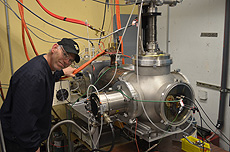Pushing accelerator technology with PXIE
 |
Engineering physicist Bruce Hanna works on the PXIE ion source test stand at Lawrence Berkeley National Laboratory. The ion source will arrive at Fermilab this month. Photo: Lionel Prost, AD |
The Intensity Frontier program planned for Fermilab's proposed Project X is an ambitious one, making extraordinary demands of its particle beams and thus of the machine that provides them. Project X teams aren't shying away from the challenge. They're tackling the machine head-on and from the front.
This month the Accelerator Sector will begin assembling the Project X Injector Experiment (PXIE), kicking off an R&D program to understand, integrate, test and hammer the dents out of this most complex subsystem in the Project X accelerator. PXIE focuses on the front-end injector of Project X, the section that prepares the beam for delivery to multiple physics experiments.
"The unique aspects of Project X are pretty much enabled by the way the front end is configured," said Steve Holmes, project manager for Project X.
The injector takes up the first roughly 40 meters of the Project X 400-meter linear accelerator. In that short length reside the novel accelerator technologies that are most crucial for Project X.
"There isn't anything similar to PXIE in the world, so in some respect we are in uncharted waters," said Sergei Nagaitsev, project scientist for Project X.
One aspect of this uncharted territory is the use of superconducting technology very early in the beam's path, well before its energy is really ramped up. Most of the world's accelerators use older, normal-conducting devices to accelerate a high-power proton beam in the early stages. By instead using superconducting structures far upstream, Project X minimizes the wall-plug energy needed for acceleration.
"Every proton linac on the planet is based on 1940s technology for the early stage of acceleration," said Associate Director for Accelerators Stuart Henderson. "This, finally, is based on 21st century technology."
Demonstrating PXIE would advance technology for other accelerators, both in the United States and throughout the world.
Project X's efficiency extends to how it would send beam. It would deliver simultaneously to multiple experiments the exact pattern of particle bunches each one requires, with no more and no less beam than needed.
The wide-band chopper is responsible for this sorting and shipping. One of PXIE's major tasks is to demonstrate that it can execute the delivery of any given particle bunch pattern and chop out unwanted bunches from the continuous stream of particles.
"We can pre-program it to say to each bunch, every 6 nanoseconds you go through and you don't go through," Holmes said. "No one's really used this device in this way for a continuous-wave particle beam before."
In addition to those at Fermilab, researchers at Argonne, Berkeley, Oak Ridge and SLAC national laboratories and in the Project X India collaboration participate in PXIE, contributing R&D and the injector's major components. The goal is to demonstrate by 2018 that the injector system works.
"If you can prove you can produce, slice and dice the beam the way you like it, with the right beam quality, then you're a lot more confident that the rest will go well downstream," Henderson said. "Relatively, the rest is a piece of cake."
—Leah Hesla
|